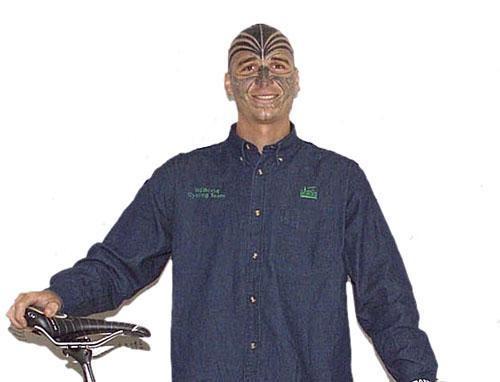Clinger back on track at Tour of Utah
Former pro kicks drug habit, begins process of removing facial tattoo

David Clinger is better known amongst his cycling peers for his somewhat shocking full facial tattoo etched under his skin. The markings are symbolic of his step down from pro bike racing, a career full of potential turned over to a world of drug abuse and occasional jail-time. Now, four years after his athletic career went awry, Clinger is back at the Tour of Utah and the infamous mask is ready to come off.
Scrolling down the list of daily results at the Tour of Utah might not reveal overwhelming success for Clinger. With the exception of a fifth place in stage one, Clinger is found mid-pack in the rankings. What the results do not show is his battle to pull his life back together after running astray from professional cycling and down a dark path of cocaine addiction that led to police arrests and subsequent time in jail. When you look at it that way, his average rank in what is billed as 'the toughest stage race in America' is nothing short of spectacular.
The facial tattoo embedded into the skin around his eyes, cheek bones and scalp begs the question, what drove this former pro, a good-looking and well-spoken guy down the wrong path? For all intents and purposes, Clinger had already made it to the top of a sport that bows down to no one.
Clinger bounced between European professional teams: the Discovery Channel team alongside Lance Armstrong, the French-based Festina squad and the Italian Domina Vacanze team, hired to work for the famed Italian sprinter, Mario Cipollini. Only Clinger himself can comprehend his downward spiral that followed the next five years.
"I had a lot of reasons to get this tattoo," said Clinger who spent two years in the province of Mendoza, Argentina, and whilst there studied the historic Maori warrior culture of New Zealand. "I was mad. A lack of respect. It was a scare tactic. The day I got the tattoo, I was walking in the park looking for cocaine and an hour later I was high. I changed in the way I started using substances. Instead of alcohol, I started using cocaine completely. My wife divorced me and every girlfriend I had didn't want a guy who used cocaine, which is understandable."
He came back to domestic American racing in 2005 with the Webcor cycling team. However, his facial tattoo, only partially complete at that time, was not something the team had signed up for. He was asked to remove the tattoo which would cost upwards of $25,000 dollars, instead he finished it off for 100 bucks, ending his relationship with Webcor. He then faded in and out of contracts with Rock Racing in 2006 and 2007, racing in the spring and then disappearing from the scene.
"I hope I didn't offend people so much that it's irreparable," Clinger said. "When I started on the circuit I never drank or stayed out late at night. But I changed in that way and started going to all the after parties and getting into drugs later on. It started innocently with a few drinks after a race and it was no harm done. But I wanted more, I wanted cocaine and cocaine is illegal everywhere so I got into trouble."
The latest race content, interviews, features, reviews and expert buying guides, direct to your inbox!
Brought up in a Mormon family in Southern California, Clinger now calls Sandy, Utah his home. He is building a new life for himself living with his extended family and reviving his faith in The Church of Jesus Christ of Latter-day Saints (LDS). He enrolled himself in The Ark of Little Cottonwood, a residential treatment and rehabilitation centre and has fought for his sobriety for nearly one year.
"I moved here and I'm removing the tattoo mostly because I was getting into so much trouble and I wasn't doing what I was taught, to stay off drugs and live a Mormon lifestyle," Clinger said. "I was sitting in a Los Angeles jail and my Dad said, 'if I help you out of jail, you have to take the tattoo off and get off drugs.' I've only been high one time since and I'm taking the tattoo off now. I was raised Mormon and they wanted to get me back to where there was a strong LDS atmosphere.
"I came up here to change my life and see what it would do for my cycling," he said. "I've been getting a lot better. I have a strong family connection here and they help me out a lot. It's the times when I'm sitting there with nothing to do that the cravings come back and it's hard to not get up and act on them."
Cycling has once again become a main focus in his life. He is racing for the local team Cole Sport and recently placed second in the Utah State Road race championships and 10th place in the state time trial championships. Having found tranquility in his life and a place of stability, Clinger seems at peace with the decision to remove his mask. He has already begun the painful process and says that he will be staying in Sandy for the better part of the next three years, which is how long it will take to remove the ink from under his skin.
"It takes three year to remove the tattoo, slowly, so you don't risk scarring," said Clinger with already noticeable results. "They have to do it slowly and it's already started to fade. They said for a little while the skin will be whiter where the tattoo was but once I tan it, it will go back to a regular color."
When asked if removing the tattoo marks a symbol of life change Clinger responded, "For me, yes, but you can always go and put it back on or do something different if you want to. I don't think I will. It's a form of art but so is cycling and I have to mold myself to the situation."

Kirsten Frattini has been the Editor of Cyclingnews since December 2025, overseeing editorial operations and output across the brand and delivering quality, engaging content.
She manages global budgets, racing & events, production scheduling, and contributor commissions, collaborating across content sections and teams in the UK, Europe, North America, and Australia to ensure audience and subscription growth across the brand.
Kirsten has a background in Kinesiology and Health Science. She has been involved in cycling from the community and grassroots level to professional cycling's biggest races, reporting on the WorldTour, Spring Classics, Tours de France, World Championships and Olympic Games.
